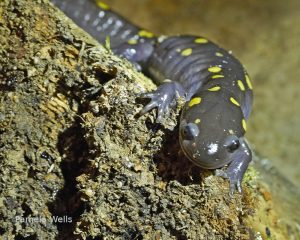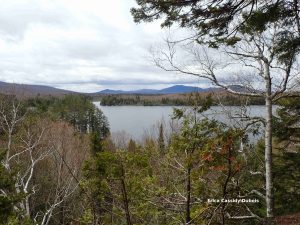-by Kristin Peet, FSM Forestland Conservation Specialist

One of my favorite spring activities is to head out after dark on a warm, rainy night in April, flashlight and camera in tow, to look for frogs and salamanders heading to vernal pools to breed. I consider it a success if I see a spotted salamander (Ambystoma maculatum)–my all-time favorite!
Vernal pools are defined as “seasonal, semi-permanent or permanent bodies of water that are essential breeding habitat for certain amphibians and invertebrates and do not support fish” (Hunter, Calhoun, & McCollough, 1999). Vernal pools generally hold water for several months in the spring and early summer and are often dry by fall. They are essential habitats because several of Maine’s amphibian species breed in them almost exclusively, including the wood frog, spotted salamander, and blue-spotted salamander. Fairy shrimp are also considered an indicator species as they breed only in these vernal pools.
Forest managers and land stewards have the vital role of being the first in line to protect these sensitive habitats, which can be easily overlooked in other seasons. Maintaining canopy cover and shade is an important component of the habitat structure of vernal pools. You can find more information on how to manage vernal pools and other conservation resources at www.maineaudubon.org/resources.
This article was originally published in the Spring 2019 edition of Forest View, FSM’s biannual newsletter.




